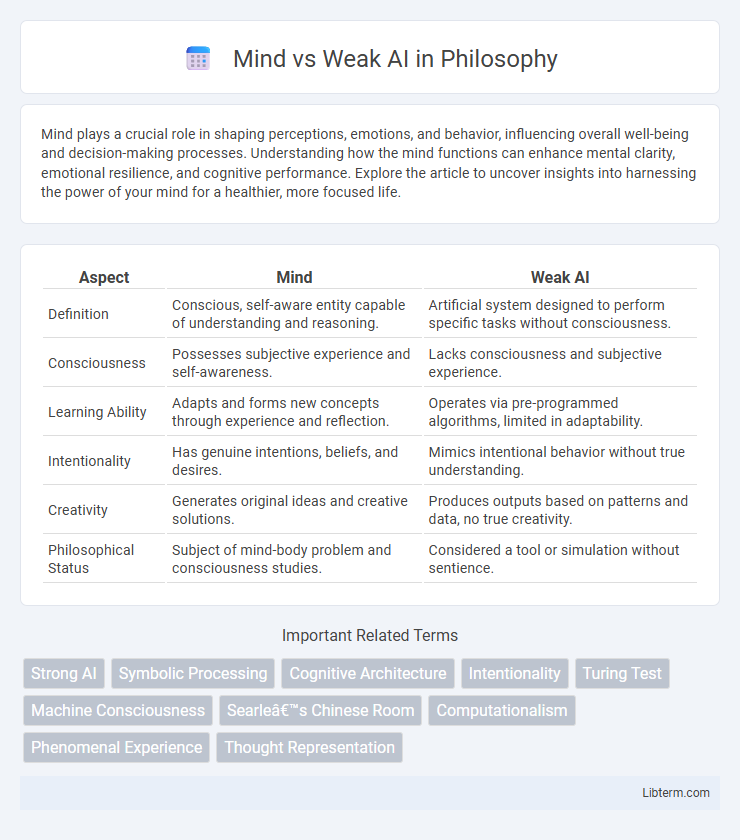Mind plays a crucial role in shaping perceptions, emotions, and behavior, influencing overall well-being and decision-making processes. Understanding how the mind functions can enhance mental clarity, emotional resilience, and cognitive performance. Explore the article to uncover insights into harnessing the power of your mind for a healthier, more focused life.
Table of Comparison
| Aspect | Mind | Weak AI |
|---|---|---|
| Definition | Conscious, self-aware entity capable of understanding and reasoning. | Artificial system designed to perform specific tasks without consciousness. |
| Consciousness | Possesses subjective experience and self-awareness. | Lacks consciousness and subjective experience. |
| Learning Ability | Adapts and forms new concepts through experience and reflection. | Operates via pre-programmed algorithms, limited in adaptability. |
| Intentionality | Has genuine intentions, beliefs, and desires. | Mimics intentional behavior without true understanding. |
| Creativity | Generates original ideas and creative solutions. | Produces outputs based on patterns and data, no true creativity. |
| Philosophical Status | Subject of mind-body problem and consciousness studies. | Considered a tool or simulation without sentience. |
Understanding Mind: Human Cognition Explained
Human cognition encompasses complex processes such as perception, memory, reasoning, and emotional understanding, which are integral to the functioning of the human mind. Unlike weak AI, which performs specific tasks based on predefined algorithms, the human mind exhibits consciousness, self-awareness, and the ability to learn from nuanced experiences. Understanding these cognitive mechanisms highlights the limitations of weak AI in replicating true human intelligence and sheds light on the intricate nature of mental processes.
Defining Weak AI: Scope and Limitations
Weak AI, also known as narrow AI, is designed to perform specific tasks without possessing genuine understanding or consciousness, operating within a limited scope defined by its programming. It excels in activities such as speech recognition, image classification, and data analysis but lacks the ability to generalize knowledge or exhibit true cognitive flexibility. The primary limitation of Weak AI lies in its inability to emulate human-like reasoning, emotions, or awareness, restricting its applications to predefined functions and rule-based problem-solving.
Consciousness and Self-awareness: A Human Trait
Mind represents a complex system characterized by consciousness and self-awareness, traits inherently unique to humans and advanced biological organisms. Weak AI operates through programmed algorithms without true understanding or subjective experience, lacking genuine consciousness or self-awareness. This distinction highlights that while Weak AI can simulate decision-making and learning, it does not possess the intrinsic mental states that define conscious human minds.
Problem-Solving Approaches: Mind vs Machine
Human minds excel at problem-solving through intuitive reasoning, creativity, and adaptive learning from diverse experiences. Weak AI employs algorithmic methods and predefined rules designed for specific tasks, lacking genuine understanding or flexible thinking. While machines can process vast data rapidly, they struggle with ambiguous or novel situations that require human-like insight and abstract reasoning.
Learning Processes: Intuition vs Algorithm
Mind-based learning relies on intuition, enabling humans to understand context, adapt to new information, and make creative decisions through subconscious processing. Weak AI operates through algorithm-driven learning, utilizing predefined models and structured data to perform specific tasks without genuine understanding or conscious thought. The distinction lies in human cognition's flexible, heuristic learning compared to weak AI's rigid, rule-based computations.
Flexibility and Adaptability: Comparing Intelligence
Mind-based AI exhibits superior flexibility and adaptability by simulating human-like cognitive processes, enabling it to handle diverse and unpredictable tasks with contextual understanding. In contrast, Weak AI operates within predefined parameters and excels only at specific, narrow functions, lacking the capability to generalize learning across varied scenarios. This fundamental difference underscores Mind AI's potential for dynamic problem-solving versus Weak AI's limited scope in specialized applications.
Contextual Understanding: Human Mind vs AI
The human mind excels in contextual understanding by integrating emotions, experiences, and abstract reasoning, enabling nuanced interpretations of complex situations. Weak AI processes data through predefined algorithms and lacks genuine comprehension, restricting its ability to adapt to novel contexts or infer meaning beyond programmed parameters. Advances in natural language processing improve AI's contextual awareness, yet it remains fundamentally inferior to the human brain's holistic and intuitive grasp of context.
Emotions and Decision-Making: The Missing Link in AI
Mind AI systems exhibit advanced emotional recognition and nuanced decision-making capabilities by integrating affective computing technologies, enabling more human-like interactions. Weak AI, restricted to predefined algorithms, lacks genuine emotional understanding and operates primarily on logical, rule-based decision-making without contextual sensitivity. The missing link in AI development lies in embedding authentic emotional intelligence, which enhances adaptive decision-making and promotes more natural, empathetic communication between machines and humans.
Ethics and Morality: Human Judgment vs AI Logic
Human judgment in ethics and morality incorporates empathy, cultural values, and contextual understanding, allowing for nuanced decisions that reflect societal norms. Weak AI operates on pre-defined algorithms and logic without genuine moral reasoning, often lacking the ability to grasp complex ethical dilemmas or emotional subtleties. This fundamental difference raises concerns about relying solely on AI for decisions requiring ethical judgment, emphasizing the necessity of human oversight in morally sensitive situations.
Future Perspectives: Bridging Mind and Artificial Intelligence
Future perspectives on bridging Mind and Weak AI focus on enhancing machine learning algorithms with cognitive architectures that emulate human reasoning and problem-solving capabilities. Integrating neuroscientific insights into AI development aims to create systems capable of adaptive learning, emotional understanding, and contextual awareness. Progress in neuro-inspired AI models promises advancements in personalized healthcare, autonomous systems, and human-computer interaction, narrowing the gap between artificial cognition and natural intelligence.
Mind Infographic

 libterm.com
libterm.com